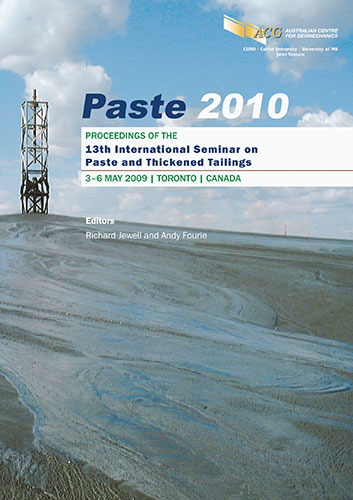Fittings losses in paste flow design

|
Authors: Slatter, PT; Fester, VG |
DOI https://doi.org/10.36487/ACG_rep/1063_26_Slatter
Cite As:
Slatter, PT & Fester, VG 2010, 'Fittings losses in paste flow design', in R Jewell & AB Fourie (eds), Paste 2010: Proceedings of the Thirteenth International Seminar on Paste and Thickened Tailings, Australian Centre for Geomechanics, Perth, pp. 303-310, https://doi.org/10.36487/ACG_rep/1063_26_Slatter
Abstract:
Accounting accurately for the losses that arise from pipe fittings, such as valves, becomes a significant and important issue, given the current emphasis on energy reducing technologies. Efficient design is only possible if reliable loss coefficient data are available. For paste slurries which are in use in many industrial settings, this situation is exacerbated by the necessity to use less water, resulting in laminar flow designs becoming more common. Against this is the prevalent design reality that whilst reliable loss coefficient data are available for turbulent Newtonian flow, this is simply not the case for laminar flow. The objective of this paper is to show that fittings losses become much more prominent in laminar flow design. Work done by the authors for the measurement of loss coefficient data on diaphragm valves is reviewed and updated. This work, which is particularly important for paste flow applications, is then used to illustrate the importance of laminar flow loss coefficient data in the context of a practical design example. Pumping power requirement inaccuracies of the order of 50% are illustrated. The literature available to the paste piping designer contains a direct contradiction, and further research on this important practical issue is called for.
References:
Crane Co. (1999) Flow of Fluids Through Valves, Fittings and Pipe, Technical paper No. 410, Crane Co., Chicago, IL,
USA.
Edwards, M.F., Jadallah, M.S.M. and Smith, R. (1985) Head losses in pipe fittings at low Reynolds numbers, Chem.
Eng. Res. Des, 63, January, pp. 43–50.
Fester, V.G., Kazadi, D.M., Mbiya, B.M. and Slatter, P.T. (2007) Loss coefficients for flow of Newtonian and non-
Newtonian fluids through diaphragm valves, Trans IChemE, Part A, Chemical Engineering Research and
Design, 85(A9), pp. 1314–1324.
Fester, V.G., Mbiya, B.M. and Slatter, P.T. (2008) Energy losses of non-Newtonian fluids in sudden pipe contractions,
Chemical Engineering Journal, Vol. 145, No. 1, pp. 57–63.
Fester, V.G. and Slatter, P.T. (2009) Dynamic Similarity for Non-Newtonian Fluids in Globe Valves, Trans IChemE,
Part A, Chemical Engineering Research and Design, Vol. 87, pp. 291–297.
Govier, G.W. and Aziz, K. (1972) The Flow of Complex Mixtures in Pipes, van Nostrand Reinhold Co.
Massey, B.S. (1970) Mechanics of fluids, Second edition, van Nostrand Reinhold Co.
Mbiya, B.M., Fester, V.G. and Slatter, P.T. (2009) Evaluating resistance coefficients of control diaphragm valves, Can.
J. Chem. Eng., Vol. 87, pp. 704–714.
Miller, D.S. (1978) Internal flow systems, Cranfield: BHRA Fluid Engineering.
Streeter, V.L. and Wylie, B. (1985) Fluid Mechanics, 6th edition, McGraw-Hill Inc., USA.
© Copyright 2025, Australian Centre for Geomechanics (ACG), The University of Western Australia. All rights reserved.
View copyright/legal information
Please direct any queries or error reports to repository-acg@uwa.edu.au
View copyright/legal information
Please direct any queries or error reports to repository-acg@uwa.edu.au